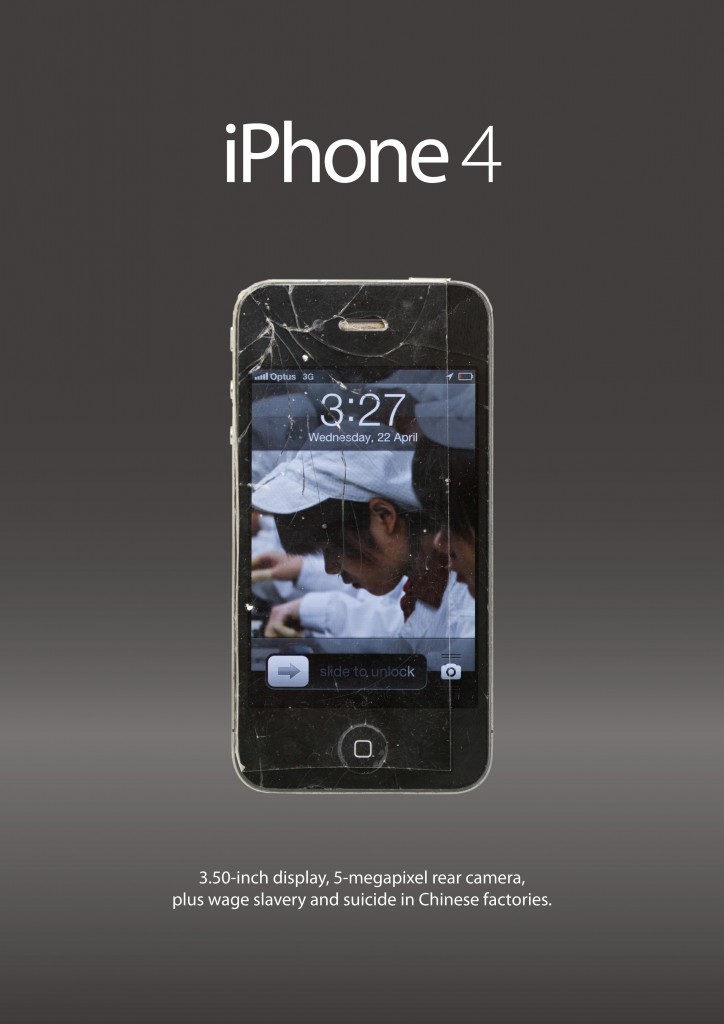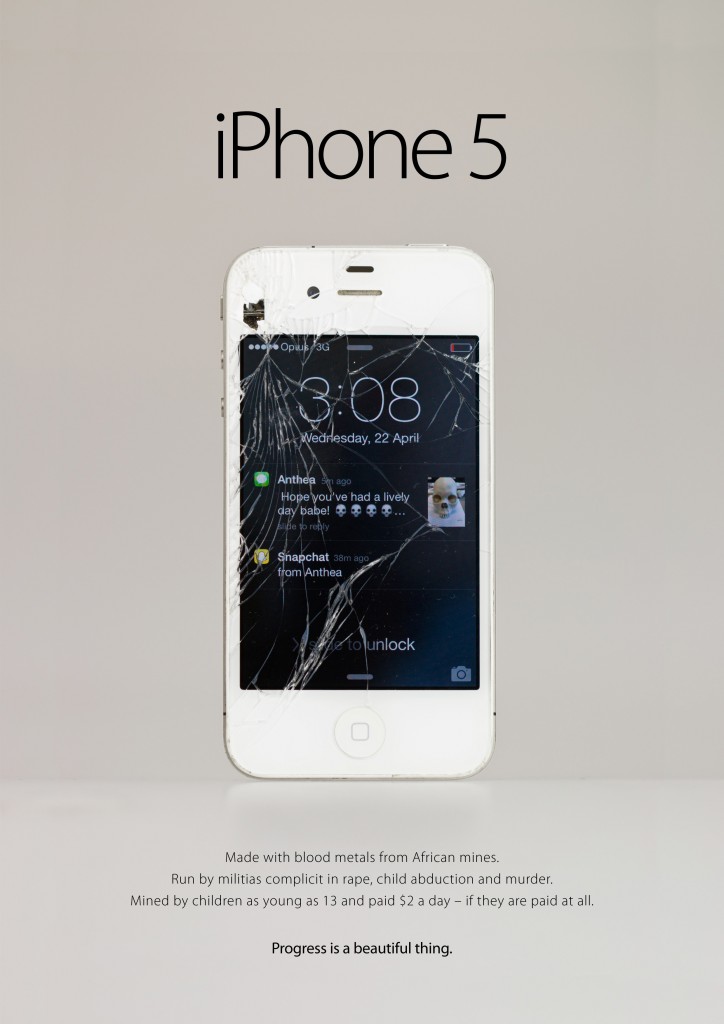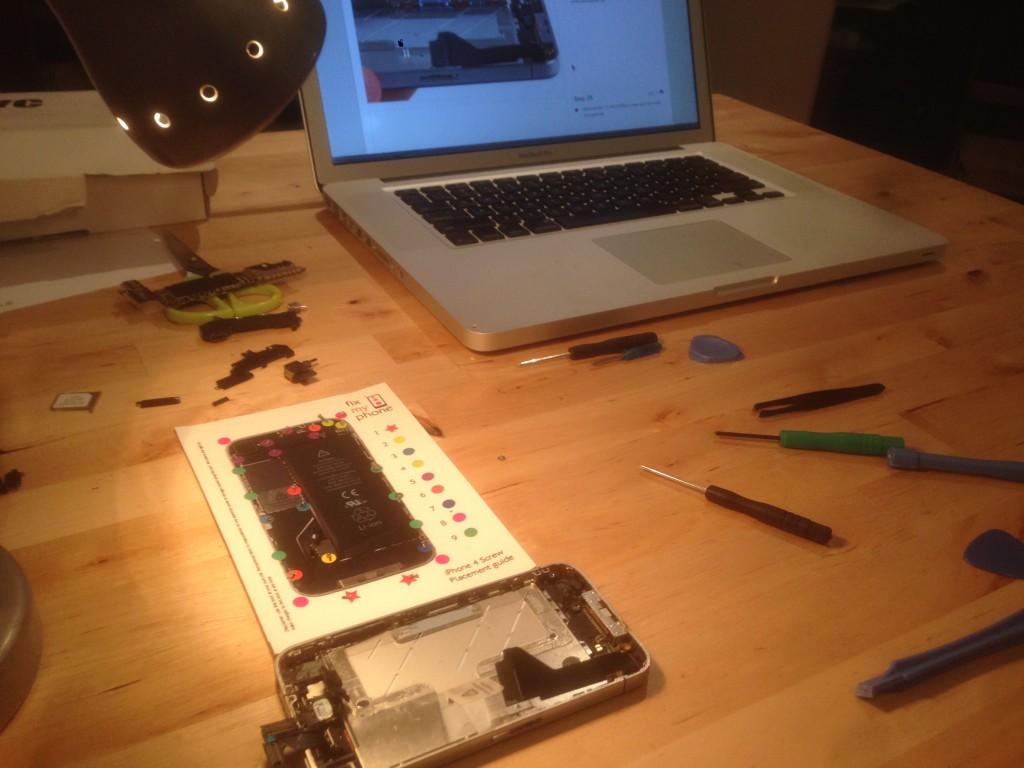three iPhones with broken screens, work in progress
Last month, my partner dropped her iPhone and broke its screen. I have previously seen many, many iPhones with broken screens. They seem to be fairly common among university students, who maybe lack the resources or time to repair them, or are otherwise content to use the phones, as is, while they still function. Its interesting to me because of something Jonathan Ive, their designer, once said about product design:
“A complex product being made is like one of those films of a glass smashing that they play backwards – all the bits come together in the right place at exactly the right time to be assembled into this thing – it’s amazing.” – Jonathan Ive, quoted in Thomas Thwaites’ The Toaster Project (2011)
To me it seems, when the literal glass of a complex product breaks, the figurative glass in that analogy also starts to shatter, and we become a little more aware of the many complex things, conditions and relations involved in the design and manufacturing of consumer electronic products. A glimpse of an interior screw or circuit hints at the many dozens or hundreds of metals and materials used in a design, some of them sourced from African conflict zones or processed from petrochemical products. We may even intuit the action of the hands and fingers that assembled the many tiny parts together. At the least, the broken screen conveys an expression of the product as waste, pulling us closer to the consideration of the demise of the product and its future in landfill, perhaps aggressively stripped and pyrochemically processed for its more valuable materials first. Using some broken iPhones sourced from friends, I produced these images to investigate this concept. The content of larger or bolded text are former iPhone slogans. The content of the smaller text has been widely reported from news articles, such as those linked above, also, concerning blood metals, here and here, concerning wage slavery in Asia, here and here, and concerning difficulties of reuse, repair, obsolescence and waste, here, here, here and here. Among dozens of other similar articles. There are other aspects of iPhone production I have not addressed in the text – for example the huge amounts of water their manufacturing requires. On the other hand, its important to understand the problem wholistically too. For example, the suicides at Foxconn have been a hot button issue, but I’ve heard it said that the suicide rate among Foxconn employees is lower the Chinese national average. Yet, this doesn’t ameliorate the problem that Foxconn and other Apple suppliers still demand their employees work far longer and cheaper than tolerated in developed countries. My point though is not to pick on Apple – the same issues concern almost all electronic manufacturers and a great number of manufacturers in general. In some regards, Apple is far better than other manufacturers. But are they good enough? Apple’s financial worth and corporate power are monumental. Their aspirational values for design are massively influential. I believe those capacities should be matched by a stronger concern for the poor and the polluted. It seems to me that Apple, perhaps more than any other corporation, is capable of properly valuing the energy and time it takes – in material and human conditions and as measured in carbon, water and life – required to make their products. The photo set on the lock screen of the second iPhone 4 is a photo of Foxconn workers in Shenzhen, taken by by Kin Cheung/AP.
A note on the repair/replacement of iPhone screens: After taking these photos I repaired the black iPhone 4 with the clear packing tape over the screen. Or rather, I replaced the broken screen, which is not strictly repair. My partner had put the packing tape on to hold the screen together and prevent hurting her finger in use. Its just as well the packing tape was there, because I read only later that once all the tiny internal screws are undone and the screen comes free from the body, the screen is liable to explode little fragments of glass into the air. Eye protection is advised, and apply packing tape beforehand if its not there already. I had previously repaired or modded Macbooks and other laptops computers, but the scale of the iPhone and its tiny, compacted components presented a challenge. It took time and required more care and precision than I expected. Each screw seemed to get smaller and smaller as I delved into the insect-like guts of the phone, testing the limits of my eyesight and hand control. Tweezers were used. I tried to not touch anything with my fingers, because little smears of skin oil can interfere with the signal antennae that conducts through the body of the device. Care also needs to be taken in returning components to their location in the same order as they were removed, complicated by little screws, washers and rubber spacers popping out unexpectedly. I made a mistake and needed to repeat a few steps. For anyone following the iFixit instructions, I recommend reading the comments attached to each instruction before following that instruction, and re-read them on re-assembly. The instructions by themselves are not complete. In the picture above, the open iPhone sits on the table adjacent to a sticky, colour-coded mat. The mat came with the replacement screen, along with some tools. As you remove the screws you stick them on the mat’s coloured dots, referencing their position inside the phone. Its a nice solution for keeping track of the screws. When I was done I reflected on the task, and I wondered about the workers that assembled the phone in the first place. This phone was no doubt just one of hundreds or thousands assembled during their days and weeks of work.



